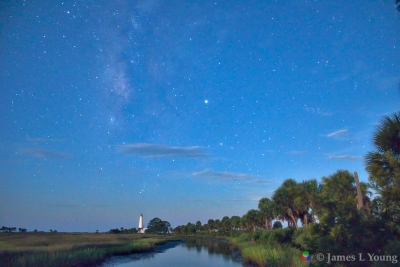When I photograph the St. Marks National Wildlife Refuge lighthouse and the Milky Way I try to avoid using electronic flash or “light painting” with a flashlight to make the lighthouse and trees more visible.
I used a flashlight in my early Milky Way photos but once during post-processing I noticed there was an owl atop of the lighthouse and decided to quit using artificial lights at night. The last thing I want to do is blind or disturb the wildlife.
In my September 2017 blog post titled “Improve terrestrial Milky Way photos using image stacking” I described taking numerous images of the Milky Way and lighthouse then stacking the images to increase the brightness and reduce noise.
The technique worked but there was still noticeable noise in the final image which required a LOT of photo editing.
This year I decided to try a simpler technique of photographing the Milky Way at night just as the moon rose in the east. If a photo is taken at just the right time the Milky Way is still visible and the lighthouse and marsh are also illuminated.
To get the timing right I took a series of 30 second exposures starting just as the moon peeked over the horizon and continuing until the Milky Way began to fade.
Below is one of the images:
I processed this image using what I call “Darktherapee” (described in another post).
RawTherapee was used to do the first processing of the image since it has very good tools to work with low light high ISO images.
The result was exported to a 32bit tif file and then loaded into Darktable where I finished the processing.
I used Darktable’s parametric mask to selectively lighten the marsh and get better contrast of the Milky Way. Selective denoising was applied since noise levels varied across the image.
This technique works well and could be enhanced using image stacking to reduce noise levels.
Photographs like this must be carefully planned. The Milky Way must be high enough in the sky to appear near the lighthouse at the same time the moon is rising.
The weather and clouds at St. Marks NWR can be tricky and often foil the best planned photo shoots.
Sadly the night sky at St. Marks is suffering from the onslaught of “civilization”.
The glow of cell towers and new housing development is making it more difficult to get a truly dark sky.
Jim

